2005 CHEVROLET EXPRESS CARGO VAN wheel
[x] Cancel search: wheelPage 232 of 388
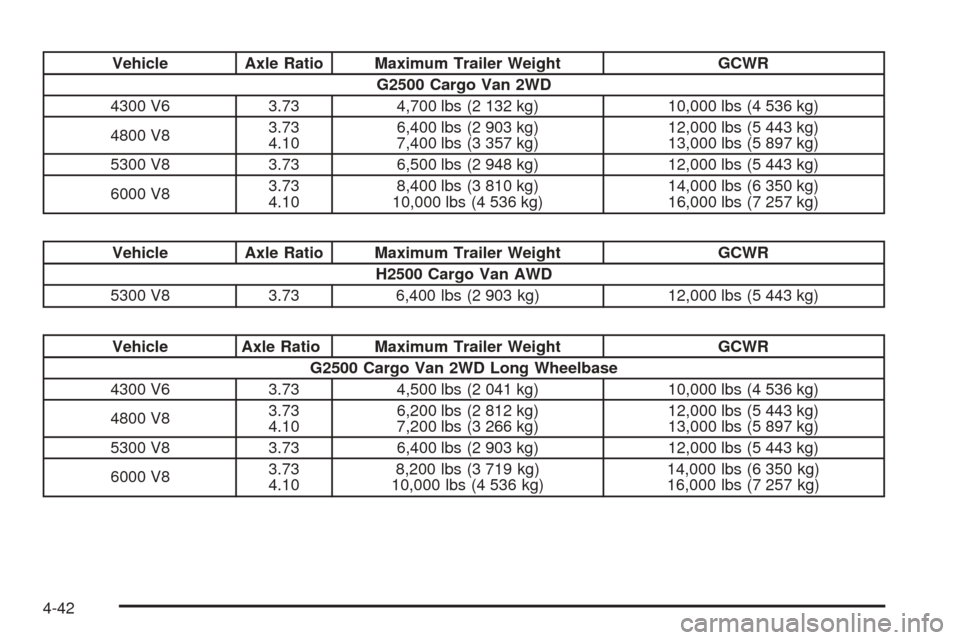
Vehicle Axle Ratio Maximum Trailer Weight GCWR
G2500 Cargo Van 2WD
4300 V6 3.73 4,700 lbs (2 132 kg) 10,000 lbs (4 536 kg)
4800 V83.73
4.106,400 lbs (2 903 kg)
7,400 lbs (3 357 kg)12,000 lbs (5 443 kg)
13,000 lbs (5 897 kg)
5300 V8 3.73 6,500 lbs (2 948 kg) 12,000 lbs (5 443 kg)
6000 V83.73
4.108,400 lbs (3 810 kg)
10,000 lbs (4 536 kg)14,000 lbs (6 350 kg)
16,000 lbs (7 257 kg)
Vehicle Axle Ratio Maximum Trailer Weight GCWR
H2500 Cargo Van AWD
5300 V8 3.73 6,400 lbs (2 903 kg) 12,000 lbs (5 443 kg)
Vehicle Axle Ratio Maximum Trailer Weight GCWR
G2500 Cargo Van 2WD Long Wheelbase
4300 V6 3.73 4,500 lbs (2 041 kg) 10,000 lbs (4 536 kg)
4800 V83.73
4.106,200 lbs (2 812 kg)
7,200 lbs (3 266 kg)12,000 lbs (5 443 kg)
13,000 lbs (5 897 kg)
5300 V8 3.73 6,400 lbs (2 903 kg) 12,000 lbs (5 443 kg)
6000 V83.73
4.108,200 lbs (3 719 kg)
10,000 lbs (4 536 kg)14,000 lbs (6 350 kg)
16,000 lbs (7 257 kg)
4-42
Page 233 of 388
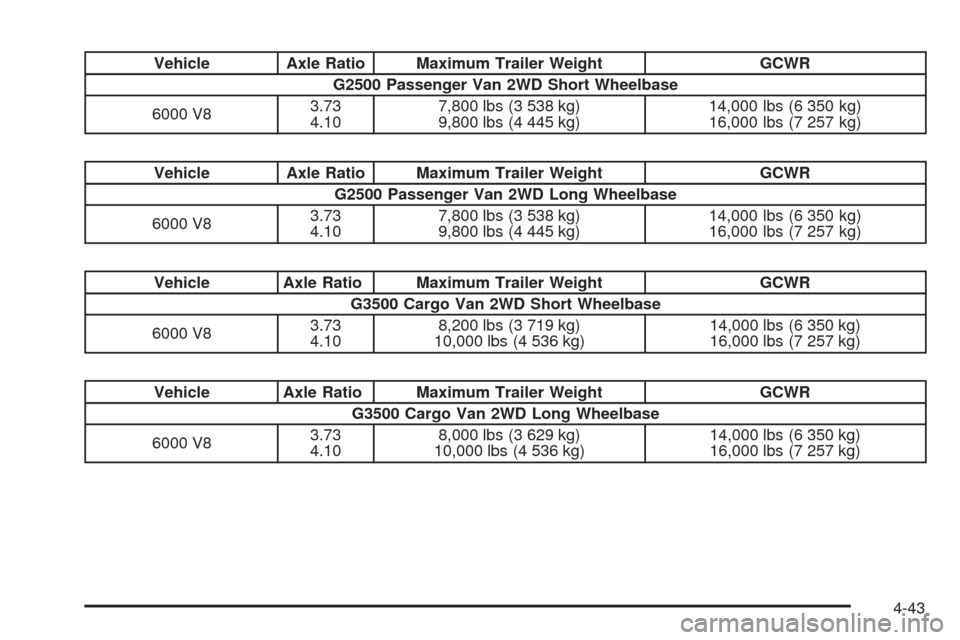
Vehicle Axle Ratio Maximum Trailer Weight GCWR
G2500 Passenger Van 2WD Short Wheelbase
6000 V83.73
4.107,800 lbs (3 538 kg)
9,800 lbs (4 445 kg)14,000 lbs (6 350 kg)
16,000 lbs (7 257 kg)
Vehicle Axle Ratio Maximum Trailer Weight GCWR
G2500 Passenger Van 2WD Long Wheelbase
6000 V83.73
4.107,800 lbs (3 538 kg)
9,800 lbs (4 445 kg)14,000 lbs (6 350 kg)
16,000 lbs (7 257 kg)
Vehicle Axle Ratio Maximum Trailer Weight GCWR
G3500 Cargo Van 2WD Short Wheelbase
6000 V83.73
4.108,200 lbs (3 719 kg)
10,000 lbs (4 536 kg)14,000 lbs (6 350 kg)
16,000 lbs (7 257 kg)
Vehicle Axle Ratio Maximum Trailer Weight GCWR
G3500 Cargo Van 2WD Long Wheelbase
6000 V83.73
4.108,000 lbs (3 629 kg)
10,000 lbs (4 536 kg)14,000 lbs (6 350 kg)
16,000 lbs (7 257 kg)
4-43
Page 234 of 388
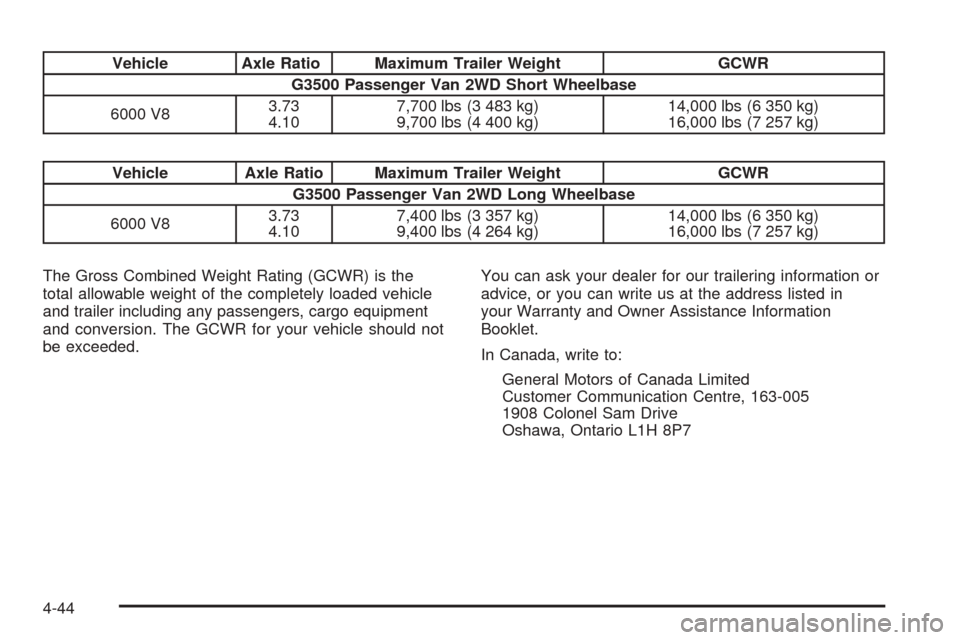
Vehicle Axle Ratio Maximum Trailer Weight GCWR
G3500 Passenger Van 2WD Short Wheelbase
6000 V83.73
4.107,700 lbs (3 483 kg)
9,700 lbs (4 400 kg)14,000 lbs (6 350 kg)
16,000 lbs (7 257 kg)
Vehicle Axle Ratio Maximum Trailer Weight GCWR
G3500 Passenger Van 2WD Long Wheelbase
6000 V83.73
4.107,400 lbs (3 357 kg)
9,400 lbs (4 264 kg)14,000 lbs (6 350 kg)
16,000 lbs (7 257 kg)
The Gross Combined Weight Rating (GCWR) is the
total allowable weight of the completely loaded vehicle
and trailer including any passengers, cargo equipment
and conversion. The GCWR for your vehicle should not
be exceeded.You can ask your dealer for our trailering information or
advice, or you can write us at the address listed in
your Warranty and Owner Assistance Information
Booklet.
In Canada, write to:
General Motors of Canada Limited
Customer Communication Centre, 163-005
1908 Colonel Sam Drive
Oshawa, Ontario L1H 8P7
4-44
Page 239 of 388

Passing
You’ll need more passing distance up ahead when
you’re towing a trailer. And, because you’re a good deal
longer, you’ll need to go much farther beyond the
passed vehicle before you can return to your lane.
Backing Up
Hold the bottom of the steering wheel with one hand.
Then, to move the trailer to the left, just move that hand
to the left. To move the trailer to the right, move your
hand to the right. Always back up slowly and, if possible,
have someone guide you.
Making Turns
Notice:Making very sharp turns while trailering
could cause the trailer to come in contact with the
vehicle. Your vehicle could be damaged. Avoid
making very sharp turns while trailering.
When you’re turning with a trailer, make wider turns than
normal. Do this so your trailer won’t strike soft shoulders,
curbs, road signs, trees or other objects. Avoid jerky or
sudden maneuvers. Signal well in advance.
Turn Signals When Towing a Trailer
When you tow a trailer, your vehicle has to have extra
wiring and a heavy-duty turn signal �asher (included
in the optional trailering package).
The arrows on your instrument panel will �ash whenever
you signal a turn or lane change. Properly hooked up,
the trailer lamps will also �ash, telling other drivers
you’re about to turn, change lanes or stop.
When towing a trailer, the arrows on your instrument
panel will �ash for turns even if the bulbs on the trailer are
burned out. Thus, you may think drivers behind you are
seeing your signal when they are not. It’s important to
check occasionally to be sure the trailer bulbs are still
working.
Driving On Grades
Reduce speed and shift to a lower gearbeforeyou start
down a long or steep downgrade. If you don’t shift
down, you might have to use your brakes so much that
they would get hot and no longer work well.
You can tow in DRIVE (D). You may want to shift the
transmission to THIRD (3) or a lower gear under heavy
loads and/or hilly conditions.
4-49
Page 240 of 388
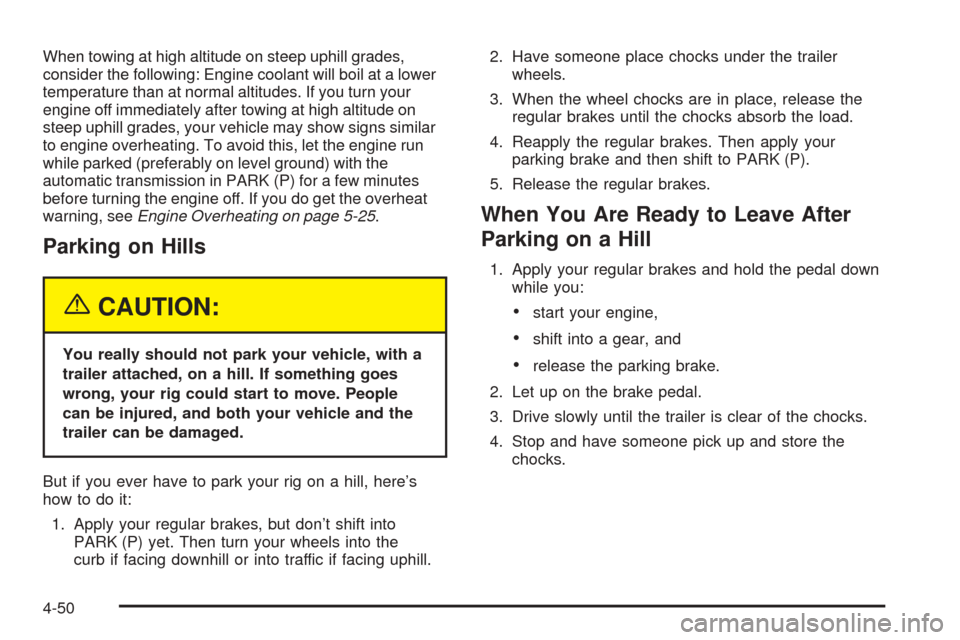
When towing at high altitude on steep uphill grades,
consider the following: Engine coolant will boil at a lower
temperature than at normal altitudes. If you turn your
engine off immediately after towing at high altitude on
steep uphill grades, your vehicle may show signs similar
to engine overheating. To avoid this, let the engine run
while parked (preferably on level ground) with the
automatic transmission in PARK (P) for a few minutes
before turning the engine off. If you do get the overheat
warning, seeEngine Overheating on page 5-25.
Parking on Hills
{CAUTION:
You really should not park your vehicle, with a
trailer attached, on a hill. If something goes
wrong, your rig could start to move. People
can be injured, and both your vehicle and the
trailer can be damaged.
But if you ever have to park your rig on a hill, here’s
how to do it:
1. Apply your regular brakes, but don’t shift into
PARK (P) yet. Then turn your wheels into the
curb if facing downhill or into traffic if facing uphill.2. Have someone place chocks under the trailer
wheels.
3. When the wheel chocks are in place, release the
regular brakes until the chocks absorb the load.
4. Reapply the regular brakes. Then apply your
parking brake and then shift to PARK (P).
5. Release the regular brakes.
When You Are Ready to Leave After
Parking on a Hill
1. Apply your regular brakes and hold the pedal down
while you:
start your engine,
shift into a gear, and
release the parking brake.
2. Let up on the brake pedal.
3. Drive slowly until the trailer is clear of the chocks.
4. Stop and have someone pick up and store the
chocks.
4-50
Page 243 of 388
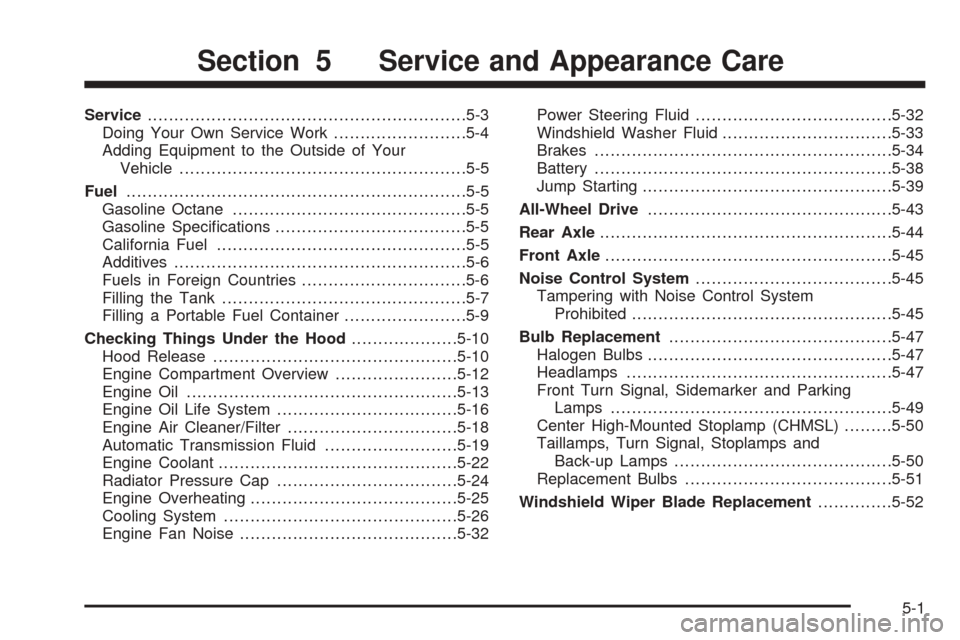
Service............................................................5-3
Doing Your Own Service Work.........................5-4
Adding Equipment to the Outside of Your
Vehicle......................................................5-5
Fuel................................................................5-5
Gasoline Octane............................................5-5
Gasoline Speci�cations....................................5-5
California Fuel...............................................5-5
Additives.......................................................5-6
Fuels in Foreign Countries...............................5-6
Filling the Tank..............................................5-7
Filling a Portable Fuel Container.......................5-9
Checking Things Under the Hood....................5-10
Hood Release..............................................5-10
Engine Compartment Overview.......................5-12
Engine Oil...................................................5-13
Engine Oil Life System..................................5-16
Engine Air Cleaner/Filter................................5-18
Automatic Transmission Fluid.........................5-19
Engine Coolant.............................................5-22
Radiator Pressure Cap..................................5-24
Engine Overheating.......................................5-25
Cooling System............................................5-26
Engine Fan Noise.........................................5-32Power Steering Fluid.....................................5-32
Windshield Washer Fluid................................5-33
Brakes........................................................5-34
Battery........................................................5-38
Jump Starting...............................................5-39
All-Wheel Drive..............................................5-43
Rear Axle.......................................................5-44
Front Axle......................................................5-45
Noise Control System.....................................5-45
Tampering with Noise Control System
Prohibited.................................................5-45
Bulb Replacement..........................................5-47
Halogen Bulbs..............................................5-47
Headlamps..................................................5-47
Front Turn Signal, Sidemarker and Parking
Lamps.....................................................5-49
Center High-Mounted Stoplamp (CHMSL).........5-50
Taillamps, Turn Signal, Stoplamps and
Back-up Lamps.........................................5-50
Replacement Bulbs.......................................5-51
Windshield Wiper Blade Replacement..............5-52
Section 5 Service and Appearance Care
5-1
Page 244 of 388
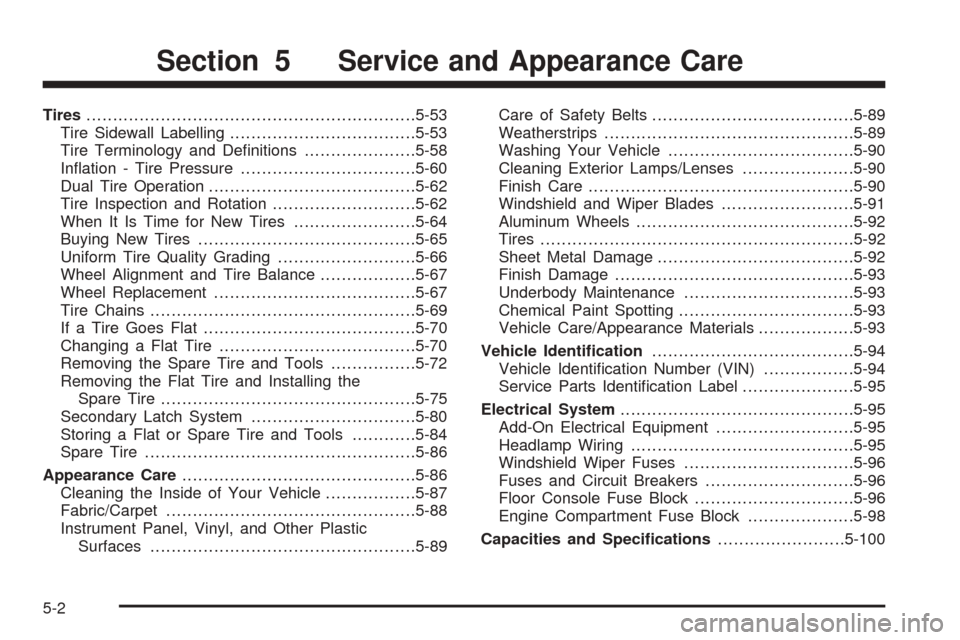
Tires..............................................................5-53
Tire Sidewall Labelling...................................5-53
Tire Terminology and De�nitions.....................5-58
In�ation - Tire Pressure.................................5-60
Dual Tire Operation.......................................5-62
Tire Inspection and Rotation...........................5-62
When It Is Time for New Tires.......................5-64
Buying New Tires.........................................5-65
Uniform Tire Quality Grading..........................5-66
Wheel Alignment and Tire Balance..................5-67
Wheel Replacement......................................5-67
Tire Chains..................................................5-69
If a Tire Goes Flat........................................5-70
Changing a Flat Tire.....................................5-70
Removing the Spare Tire and Tools................5-72
Removing the Flat Tire and Installing the
Spare Tire................................................5-75
Secondary Latch System...............................5-80
Storing a Flat or Spare Tire and Tools............5-84
Spare Tire...................................................5-86
Appearance Care............................................5-86
Cleaning the Inside of Your Vehicle.................5-87
Fabric/Carpet...............................................5-88
Instrument Panel, Vinyl, and Other Plastic
Surfaces..................................................5-89Care of Safety Belts......................................5-89
Weatherstrips...............................................5-89
Washing Your Vehicle...................................5-90
Cleaning Exterior Lamps/Lenses.....................5-90
Finish Care..................................................5-90
Windshield and Wiper Blades.........................5-91
Aluminum Wheels.........................................5-92
Tires...........................................................5-92
Sheet Metal Damage.....................................5-92
Finish Damage.............................................5-93
Underbody Maintenance................................5-93
Chemical Paint Spotting.................................5-93
Vehicle Care/Appearance Materials..................5-93
Vehicle Identi�cation......................................5-94
Vehicle Identi�cation Number (VIN).................5-94
Service Parts Identi�cation Label.....................5-95
Electrical System............................................5-95
Add-On Electrical Equipment..........................5-95
Headlamp Wiring..........................................5-95
Windshield Wiper Fuses................................5-96
Fuses and Circuit Breakers............................5-96
Floor Console Fuse Block..............................5-96
Engine Compartment Fuse Block....................5-98
Capacities and Speci�cations........................5-100
Section 5 Service and Appearance Care
5-2
Page 279 of 388
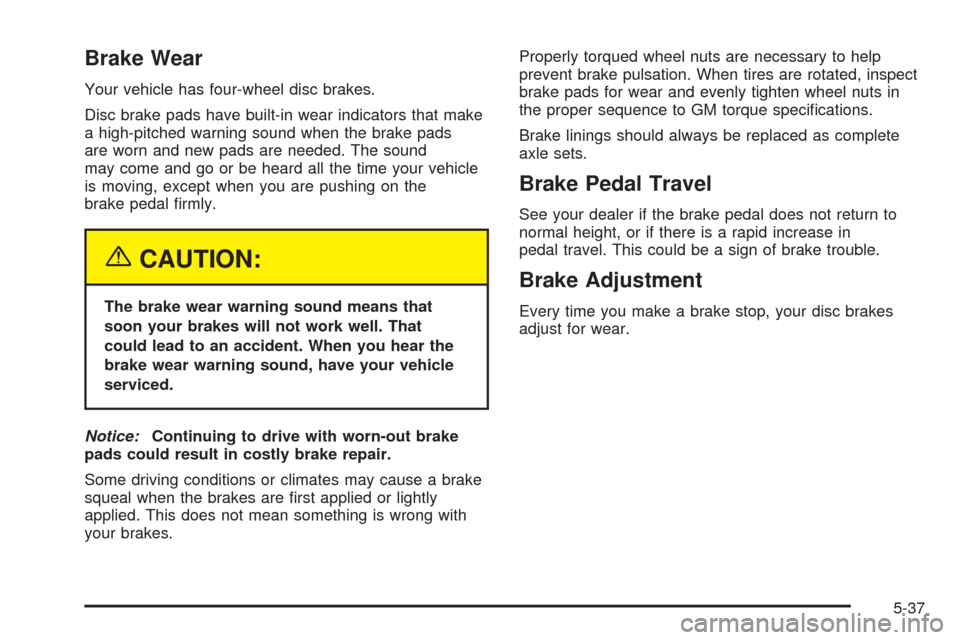
Brake Wear
Your vehicle has four-wheel disc brakes.
Disc brake pads have built-in wear indicators that make
a high-pitched warning sound when the brake pads
are worn and new pads are needed. The sound
may come and go or be heard all the time your vehicle
is moving, except when you are pushing on the
brake pedal �rmly.
{CAUTION:
The brake wear warning sound means that
soon your brakes will not work well. That
could lead to an accident. When you hear the
brake wear warning sound, have your vehicle
serviced.
Notice:Continuing to drive with worn-out brake
pads could result in costly brake repair.
Some driving conditions or climates may cause a brake
squeal when the brakes are �rst applied or lightly
applied. This does not mean something is wrong with
your brakes.Properly torqued wheel nuts are necessary to help
prevent brake pulsation. When tires are rotated, inspect
brake pads for wear and evenly tighten wheel nuts in
the proper sequence to GM torque speci�cations.
Brake linings should always be replaced as complete
axle sets.
Brake Pedal Travel
See your dealer if the brake pedal does not return to
normal height, or if there is a rapid increase in
pedal travel. This could be a sign of brake trouble.
Brake Adjustment
Every time you make a brake stop, your disc brakes
adjust for wear.
5-37